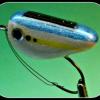Search the Community
Showing results for tags 'vibrating lures'.
-
Solar powered and battery powered vibrating fishing lures are something I’ve been working on since the late part of 2012. In this last year I finally figured out how to do the battery powered version. The difficulty with the battery powered version was figuring out how to seal the battery compartment & Motor compartment so water did not get inside. The information I am providing will give, anyone interested, a jump start on the learning curve I’ve gone through. First, before I get started, I want to tell you more about the successful testing of my lures. Over the last two years, I have had several people, some that have bought and loved my lures and others that are personal friend. They have been tested in Maryland, North Carolina, Georgia, Florida, California and in NSW Australia. They have been tested against other electronic type lures, such as the Livingston lures and a few others that use LED lights. In every case, my vibrating lures have outperformed in attracting fish. To test the lure’s fish attracting ability, I’d simply throw the different lures out and watch, with my polarized sunglasses on, to see if small bait fish would be drawn to the lure. It’s really quite amazing to see them gather around my lure as if mesmerized by the sound/vibrations. Neither of the other lures, including the Livingston lures had the same results. After I started putting legs on my lures, such as my popper and winged bugs, larger size panfish would not only be mesmerized, by the sound, they would strike. A few of my friends have told me that they have caught bass, with the battery powered versions, where bass were drawn to the lure from as far away as 50 feet. I have personally not seen this, perhaps because the waters, here in Georgia, are not so clear. Originally, my work was focused on making small, bug like, lures. I assumed fish were attracted to the sound and vibrations like they are to bugs. But, in, the most recent test, in Australia, in saltwater where visibility is up to 100 feet, a weighted jig type prototype lure was provided to test and in the words of my friend, “The fish were not only attracted, they were killing it.” So, it appears, the vibrations and sound from these motors are not only good for topwater lures, but other lures as well. My final comment before getting started is this: Even with all the testing and positive results, one fact still remains true; the lure design and look is still very important. From my experience and observations, the vibrations and noise from my lures do, in fact, provide an advantage of attracting the attentions of fish, but if the lure or the action, of the lure, does not look like something a fish would want to kill or eat, it is less likely the fish will strike. So, let’s get started: The picture below shows parts I bought and parts I made to make both the solar powered and battery powered lure versions: Solar Powered Cockroach: Purchased on eBay 1.5 ml plastic vial - Purchased on eBay Spring from a retractable ballpoint pen. Spring, handmade with 0.024” stainless wire - from Lure Parts Online Molded part for motor contact springs and motor - master part made by me, mold made with Alumilite silicone rubber and the part cast with Alumilite white and yellow die. E6000 glue for sealing the wires holes in the molded part and for lightly anchoring the motor into the molded part. There are, of course, other things made and purchased to make my master lures, my hooks, through wire, etc. I am sure these items will be explained as I continue to explain the method of making the lures. I will be posting more information on how these parts are made, shaped and used to make the motor / battery compartment of my lures. I think this is a good start to get you thinking.
- 105 replies
-
- 1
-

-
- vibrating lures
- bass lures
- (and 2 more)



